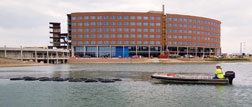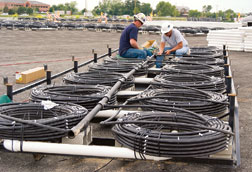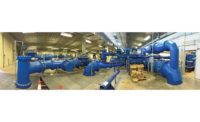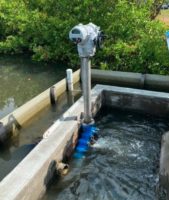Rising energy prices have project owners crunching the numbers, and some are finding that “hot” green technologies, such as geothermal heat exchange, can generate cold cash.
 Mechanical Inc. Workers float and sink 150 miles of tubing into stormwater pond to create one of the world’s largest geothermal lakes. loops.
|
Sherman Health, owner of a 255-bed hospital going up in the Chicago suburb of Elgin, Ill., plans to save more than $1 million a year by tapping into a 15-acre, 17-ft-deep geothermal lake—one of the world’s largest—which will provide heating and cooling for the 650,000-sq-ft facility. The decision to go geothermal for the $310-million project, which broke ground in June 2006 and is scheduled to open in early 2010, was a “fiscally responsible” choice, owner officials say.
Geothermal heat exchange can be especially attractive for commercial buildings that continually shed heat. Hospitals, with their warm X-ray equipment, computers and operating-room lights, are a perfect fit, says Jim Bose, executive director of Stillwater, Okla.-based International Ground Source Heat Pump Association. “We say that if you have a pond out in the back, that’s just like stealing from the bank,” he says.
Between the people and the equipment, “there’s a lot of hot air,” says Dawn Stoner, Sherman project specialist. When the building needs to cool—most of the year—the pumps remove heat from inside the rooms and transfer it to the lake where it dissipates. When the building needs warm air, the pumps draw heat from the lake, even at winter-cold temperatures, and bring it inside.
The geothermal market in the U.S. has been growing at a steady 30% clip year over year, but it still represents only 1% of the total share of all air-handling applications, says John Kelly, executive director of Washington, D.C.-based Geothermal Heat Pump Consortium Inc., a national trade group. Upfront costs are a huge factor. Loops buried in the ground require drilling or trenching equipment and labor, and not everyone has space to build a pond next door.
 Mechanical Inc. Workers place coils on exchanger jig for an air system that is 35% more efficient.
|
“As a general rule, the geothermal heat-pump unit is roughly the same cost as a conventional furnace,” Kelly says. “The additional cost is burying the piping in the ground.” That investment—up to double that of conventional heating, ventilation and air-conditioning systems—can pay off faster if a pond already exists. Sherman knew that it already needed to build a 5-acre detention pond on its 154-acre site, so it tripled the pond’s size to accommodate a geothermal loop. “Obviously, they already had plenty of ground,” adds Warren Lloyd, project manager of Rock Island, Ill.-based KJWW Engineering Consultants. “But it was $160,000 an acre. If we are going to make a 15-acre lake, it is going to be part of an economic analysis.”
KJWW had already designed the second-largest lake loop in the country, a 13-acre exchanger for Great River Medical Center in West Burlington, Iowa, which opened in 2000. Skeptical but open to the idea, Sherman’s officials kicked the tires of that facility and figured their own loop would cost $4.5 million to install. Add to that $1.6 million for the land, and the owner was looking at a $6.1-million investment. But at a savings of over $1 million per year, it wouldn’t take long to pay off. “Without the land, it was 4.82 years,” Lloyd explains. “Payback with the land is 6.52 years.” The savings are probably even more today, Stoner adds. “Over the last two years, design prices have only escalated,” she says. “It just made sense.”
Installing the lake loop for the hospital's 2,450-ton-capacity HVAC system, took time to master. “It is simple in theory, but you are talking about thousands of feet of pipe,” says Selena Worster, project manager for Hillside, Ill.-based Mechanical Inc., the installer. Steel jigs helped plumbers place coils of 3⁄4-in.-dia tubing on PVC “rafts” floated into position and sunk into the water. Larger 2-in.-dia header tubes lead into a manifold room where engineers can isolate each heat exchanger for maintenance. In total, the system sports 150 miles of high-density polyethylene tubing, 175 underwater heat exchangers and 750 indoor water-to-air heat pumps. A nontoxic, water-methanol solution will flow through the loop, turning the lake into what Lloyd calls “a 15-acre cooling tower.”



Post a comment to this article
Report Abusive Comment